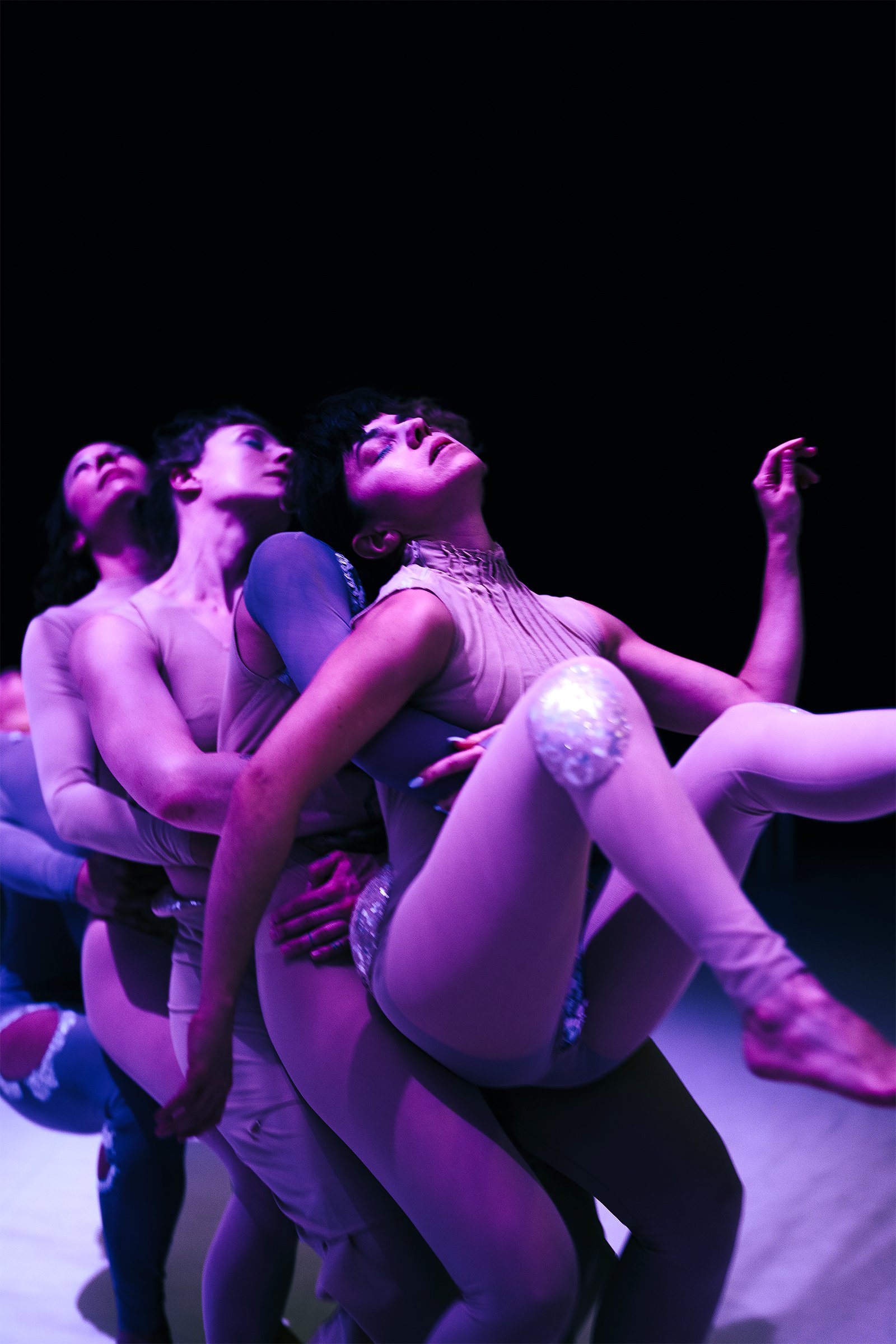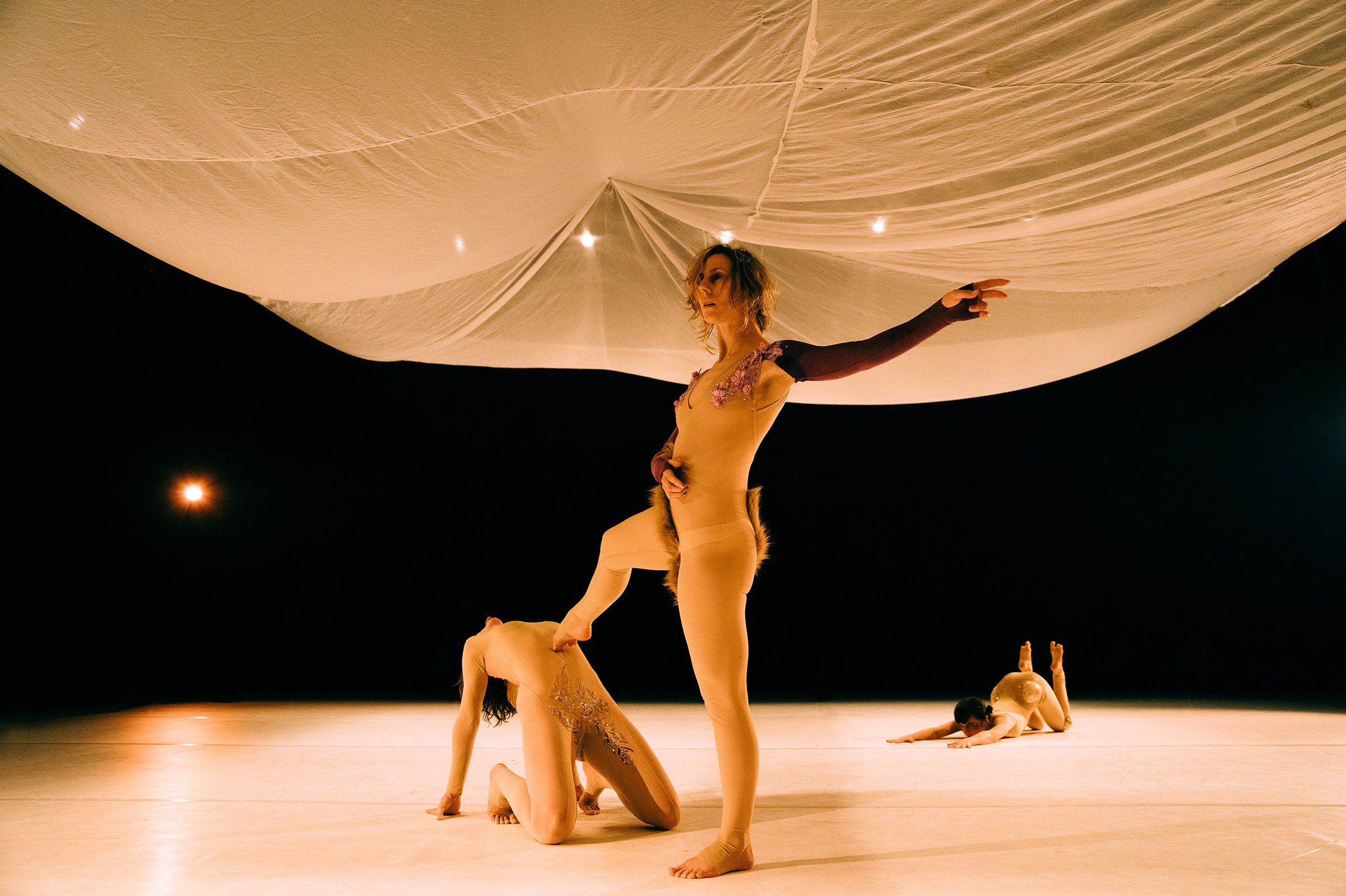La Tresse - Pursuing Harmony
Geneviève Boulet, Laura Toma, Erin O'Loughlin
Photo by Valérie Boulet
feeeee
ooooot
baaaaa
kinnnn
I arrived for the matinee showing of KIN at Agora Danse to a humming crowd of families, impeccably well-dressed people, and a small group of what I can only presume are young dancers milling near the bathrooms (I see you sweatpants-and-barefeet – as one dancer to another, I can smell the marks of post-rehearsal on you.) After picking out my favourite glasses, earrings, and hairstyles we line up to enter into Agora’s Orange space theatre.
And then, I am transported.
The theatre is swooning in a purple haze with dancers climbing over seats, cooing and snarling. Some are laying on the stage floor, drumming their fingers repeatedly, looking at us with an expression that tells me I have just entered into another world. Their world. And is that a faint scent I smell? (It is! Chatting with La TRESSE later on, they revealed they had actually hired an olfactory designer to produce a specific scent to be distributed into the theatre space. I am still boggled that olfactory design is a thing, and that La TRESSE was thoughtful and creative enough to seek it out for a dance performance.)
Hanging in the centre of the stage a large, white, sheet sways gently. Kind of in the shape of a circus tent-top, only this one is much softer and kinder. The dancers continue moving about the stage and audience, chirping, chittering, growling, and snarling. Taking deep sighs and whines all the while moving their body in small, intricate ways. Twitching, and gesturing. Like watching bacteria under a microscope wiggle and dart around.
Slowly, they begin to assemble on the stage and low voices begin to sing. Sparingly at first, and then louder and more in a kind of a call-and-response to each-other:
feeeee
ooooot
baaaaa
kinnnn
When I was able to meet up with the brilliant minds and bodies of La TRESSE a week later, they told me this kind of singing is called a hocket, or hocketing, where each person sings a different note, alternating between them, and together they form a melody. For the music nerds out there (my partner) it is a medieval polyphonic linear technique that alternates between notes, pitches, or chords with two or more voices or instruments.
Except, it’s not just a musical device. It’s also a metaphor for La TRESSE’s collective itself. Founding member Erin O'Loughlin notes:
“We started researching hocketing, and then found it really connects, because it is based on bird songs and it relates on a conceptual level, how we are a collective that transfers the lead. It's also how that works with the voice and the ways it transfers lead, so the voices become indistinguishable.”
And while use of the voice had always been a part of their practice, having worked from Romanian and Gaelic folk songs in the past, their decision to use hocketing was a choice made to try and envelop the audience by sound, to help further sensorially bring the audience inside of their world.
The choreography itself felt similarly, with the five dancers often becoming one entangled body, until one or two dancers would spill from the group only to seamlessly enmesh themselves back in later on. The movement was organic, awkward, and soft. Intimate. Sometimes I wondered if they were mycelium, or my gut biome. Other times they simply seemed to be not of this Earth. It was like watching bodies transform themselves into flowers that grow along the mountainside. They were like worms making tunnels through the soil, but also, they were all of the roots they encountered along the way. It had this spontaneous feeling to it, like when you step on a stick and hear a satisfying crack. It was this sense of how things amalgamate and become something different, an ever-present notion of how the smallest of changes can subtly ripple through an environment. Under the white sheet, the dancing became a living landscape, and the dancers were simply inviting us to witness. It was sensuous and alive, welcoming without asking you to understand exactly how it was happening.
Their collective operates under similar conditions. With more than 10 years creating together, when I asked them how they’ve done it, Erin simply said “most people have to see it to believe it.”
In part, they mention luck. They happened to share a similar aesthetic and movement training before having met one another, in addition to just liking each other as people. But more so, it’s the desire to be in good relation with one another.
“Yeah, the whole outside-of-the-studio thing is actually quite real, and not in the sense that we want to impose this kind of like family-esque thing, but more in terms of the invisible thing that happens when you spend time together. It enriches the world. It's very fundamental to our signature.”
And when I mention that it seems like they have an almost telepathic quality to how they work, Geneviève Boulet is quick to point out, “We really work on our communication, all the time. Actively. Because it's very cool that we do have that quality. But it's also not to be taken for granted.”
Nasiv Sall, Laura Toma, Erin O'Loughlin, Lucy M. May, Geneviève Boulet, Matthew Quigley
Photo by Valérie Boulet
They tell me about how informative their residencies have been to the creation of the piece, notably the Banff Centre residency, where they often took time to simply experience the mountains and nature, valuing how that would not only show up in their movement explorations, but also in their relationships. They made clear that a lot of the work was only possible because of their deep respect and trust in the friendships they had cultivated over the years. When I ask how they have managed to sustain themselves inside both personal and professional contexts, they acknowledge that they are able to “divide and conquer” a lot of the admin work. Laura has a background in design, Geneviève often acts as HR and works through most of the production needs, and Erin has a knack for accounting.
“I think there has to be a common desire for personal growth inside a collective. If there isn't love, then there isn't a collective," Geneviève tells me.
The emotional arc of the piece culminated in a vibrant and harmonious swell of singing accompanied by the sounds of Montreal’s phenomenal Shash’U. The hocketing became more pronounced and layered, both recorded and live, the soft purple and blue lighting bringing an ethereal quality to the dancers’ movements. The white sheet hanging above (lovingly named “Mother” by the collective) was womb-like, gently encasing the dancers from above, always inviting the audience inside.
At the end of the 90 minutes, we were portaled back to the Orange space’s lobby and bar to a spread of different shaped glasses filled with a chocolate mousse, Oreo ‘dirt’ and edible flowers arranged on top. They were disappearing quickly, so I made sure to grab one because I am a sweet-toothed sucker at heart. During the eating of this vegan and gluten free (and really, really good dessert! Definitely my new go-to for potlucks) it struck me how sensuously complex the work of KIN was. Their work was for my eyes, ears, nose, and mouth. It was also for my heart, pulling deeply at a sense of belonging that moved beyond something I knew how to name.
Feeling both satisfied, mystified and a little emotional, I left Agora listening to the faint sounds sung by the remaining audience members.
feeeee
ooooot
baaaaa
kinnnn
For more information on La Tresse, visit their WEBSITE.




